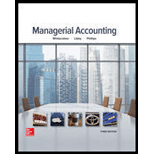
Analyzing Multiproduct CVP Biscayne’s Rent-A-Ride rents two models of automobiles: the standard and the deluxe. Information follows:

Biscayne’s total fixed cost is $18,500 per month.
1. Determine the contribution margin per rental day and contribution margin ratio for each model that Biscayne’s offers.
2. Which model would Biscayne’s prefer to rent? Explain your answer.
3. Calculate Biscayne’s break-even point if the product mix is 50/50.
4. Calculate the break-even point if Biscayne’s product mix changes so that the standard model is rented 75 percent of the time and the deluxe model is rented for only 25 percent.
5. Calculate the break-even point if Biscayne’s product mix changes so that the standard model is rented 25 percent of the time and the deluxe model is rented for 75 percent.
(a)
Contribution Margin:
The margin of profit which is computed after considering the variable cost only and not the fixed costis known as contribution. In other words, it means the contribution made by selling the product after covering its variable cost to the company.
The contribution marginand contribution margin ratio.
Answer to Problem 16E
The contribution margin for standard is
Explanation of Solution
Contribution Margin Income Statement
| Particulars | Standard | Deluxe |
| Rental Price |
||
| Variable Cost per Canoe |
||
| Contribution Margin |
(b)
Contribution Margin:
The margin of profit which is computed after considering the variable cost only and not the fixed costis known as contribution. In other words, it means the contribution made by selling the product after covering its variable cost to the company.
The model to be preferred to give on rent.
Answer to Problem 16E
The preference for providing the automobiles on rent depends on the demand of rides per day of the two models.
Explanation of Solution
The contribution margin for standard is
The contribution margin of deluxe model is higher, it means that if the demand of rides per day is more then this model should be preferred. In case the demand of rides is limited, the standard model should be preferred as the contribution margin ratio in terms of percentage of sales is higher than the deluxe model.
(c)
Concept introduction:
Breakeven Point:
The level of sales where the company is neither on profit nor loss is termed as breakeven point. In other words, that level of sales at which the fixed cost of the business is recovered.
The breakeven point if the product mix is
Answer to Problem 16E
The breakeven point in units is
Explanation of Solution
Contribution Margin Income Statement
| Particulars | Standard | Deluxe |
| Rental Price |
||
| Variable Cost per Canoe |
||
| Contribution Margin |
As the product mix is
So, the weighted contribution margin is calculated as:
The break-even point in units is calculated as:
(d)
Concept introduction:
Breakeven Point:
The level of sales where the company is neither on profit nor loss is termed as breakeven point. In other words, that level of sales at which the fixed cost of the business is recovered.
The breakeven point if the product mix changes to
Answer to Problem 16E
The breakeven point in units is
Explanation of Solution
Contribution Margin Income Statement
| Particulars | Standard | Deluxe |
| Rental Price |
||
| Variable Cost per Canoe |
||
| Contribution Margin |
As the product mix is
So, the weighted contribution margin is calculated as:
The break-even point in units is calculated as:
(e)
Concept introduction:
Breakeven Point:
The level of sales where the company is neither on profit nor loss is termed as breakeven point. In other words, that level of sales at which the fixed cost of the business is recovered.
The breakeven point if the product mix changes to
Answer to Problem 16E
The breakeven point in units is
Explanation of Solution
Contribution Margin Income Statement
| Particulars | Standard | Deluxe |
| Rental Price |
||
| Variable Cost per Canoe |
||
| Contribution Margin |
As the product mix is
So, the weighted contribution margin is calculated as:
The break-even point in units is calculated as:
Want to see more full solutions like this?
Chapter 6 Solutions
Managerial Accounting
- Which of the following is an intangible asset? A) InventoryB) CopyrightC) EquipmentD) Accounts Receivablearrow_forwardWhat does a ledger account represent? A) A detailed record of all business transactionsB) A summary of trial balancesC) An individual record for each accountD) The final balance of a financial statement Need help!arrow_forwardWhat is the primary purpose of accounting? A) To generate tax revenueB) To record, summarize, and report financial transactionsC) To determine the market value of assetsD) To manage payrollarrow_forward
- Principles of Accounting Volume 2AccountingISBN:9781947172609Author:OpenStaxPublisher:OpenStax College
 Managerial Accounting: The Cornerstone of Busines...AccountingISBN:9781337115773Author:Maryanne M. Mowen, Don R. Hansen, Dan L. HeitgerPublisher:Cengage Learning
Managerial Accounting: The Cornerstone of Busines...AccountingISBN:9781337115773Author:Maryanne M. Mowen, Don R. Hansen, Dan L. HeitgerPublisher:Cengage Learning Cornerstones of Cost Management (Cornerstones Ser...AccountingISBN:9781305970663Author:Don R. Hansen, Maryanne M. MowenPublisher:Cengage Learning
Cornerstones of Cost Management (Cornerstones Ser...AccountingISBN:9781305970663Author:Don R. Hansen, Maryanne M. MowenPublisher:Cengage Learning


